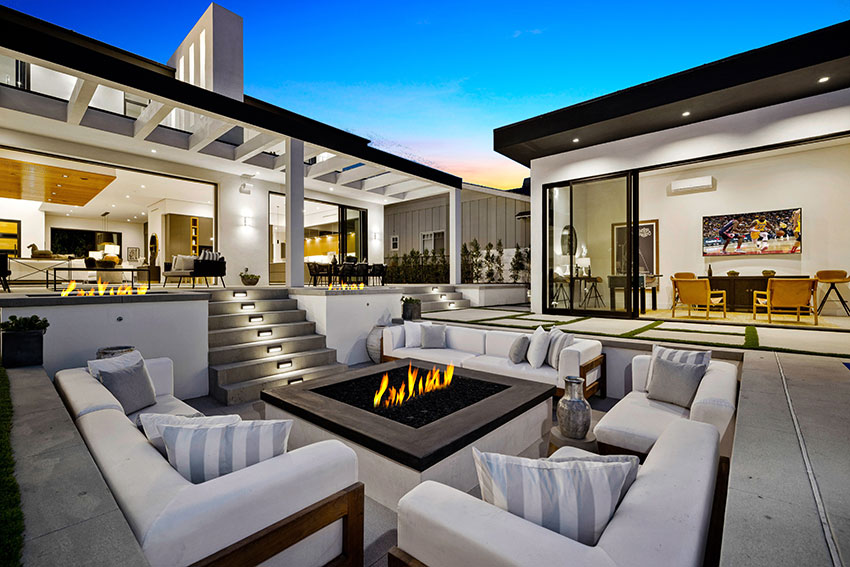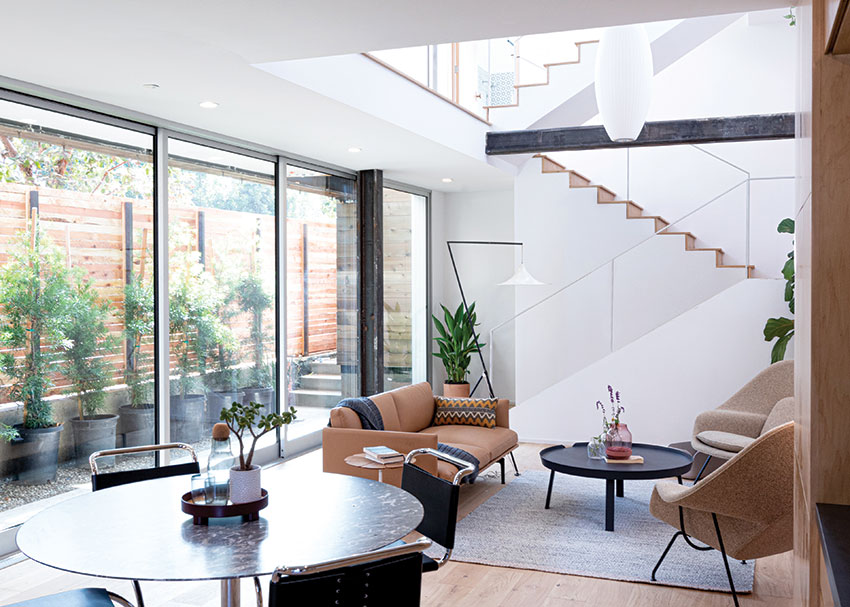A Metal for All Projects
Aluminum is 100% recyclable and retains all its properties indefinitely. It takes just 8% of the energy required to produce products from raw aluminum to recycle aluminum, and it creates just 8% of the emissions of primary production. A 10% increase in recycling rates decreases primary energy demand and greenhouse gas emissions by 15%.
Annual benefits of recycling include saving about 70 million barrels of crude oil, 2.4 million acres of land, 45 million tons of fresh and seawater usage, 7.5 million tons of solid waste, and 27 million tons of CO2.
Aluminum is one of the only materials in the consumer disposal stream that more than pays for the cost of its own collection. A 2004 study by Delft University of Technology in the Netherlands concluded that roughly 95% of the aluminum collected from buildings is recycled.

Photo by American Modular Systems; courtesy of All Weather Architectural Aluminum
Because of the unique environmentally responsible qualities of aluminum, the metal can easily contribute to the sustainability and IEQ goals of a project. The Manteca RECA.
ALUMINUM AND SUSTAINABLE DESIGN
As noted above, aluminum as a building material can contribute to a wide range of green building certification and third-party rating programs in several areas, including energy efficiency, material sustainability, and indoor environmental quality. This is especially true for fenestration. The use of aluminum extrusions allows architects to meet the challenges of sustainable design and provides many benefits to the whole-building design concept.
Aluminum-framed products meet thermal performance requirements with increased use of thermal barriers, low-E glass, and triple glazing. Aluminum windows and doors help satisfy daylighting requirements, aluminum sunshades help meet shading requirements, and aluminum products contribute to the sustainable material requirements. All told, aluminum is capable of meeting or exceeding every standard for high performance currently on the market.
For instance, U-factors for the 2021 International Energy Conservation Code (IECC) had significant changes from the 2018 version. Aluminum windows and doors can meet the thermal requirements of all these codes with increased use of thermal breaks and upgraded glazing strategies. In addition, they can satisfy all daylighting requirements. Daylighting is also becoming a more important consideration as there is a steadily rising focus on occupant health and well-being in building design and certification.
It is also important to note that the durability of aluminum provides for a long life. In North America, it is estimated that at least 85% of all aluminum shipped to the construction sector is still in productive use today, 12% has been recycled in the form of end-of-life scrap/resource, and only 3% has been lost in the natural environment.

Photo courtesy of All Weather Architectural Aluminum
The Brewster Estate utilized matching aluminum windows and large sliding doors to create a contemporary flow from interior to exterior.

Photo by Chip Allen Photography; courtesy of All Weather Architectural Aluminum
815 Tennessee is a 5-story, 69-unit luxury residential project in the historic Dogpatch District in San Francisco that features matching aluminum doors and windows and incorporates a historic brick factory building in its overall design.
Aluminum Improving IEQ
The focus on incorporating indoor environmental quality (IEQ) in the built environment has gained traction over the past decade. IEQ is the marriage of sustainability building goals and the desire to improve overall occupant health and well-being in the built environment. IEQ spans all parts of the design and construction process, from accessibility to biophilia, and indoor air quality (IAQ) to noise control. This new focus on IEQ has brought about an awareness as to which products, materials, and design elements can enhance daylighting, improve acoustics, and promote positive behaviors around physical and mental well-being–all of these aspects are becoming integral to the conversation.
Aluminum framing has the potential to support IEQ. Because the healthy building concept includes sustainability within its principles, aluminum meets those needs as well, thanks to its inherent physical properties.
Education, health care, and retail building project designers have also begun to understand the healthy building movement as key to their design successes. Research has shown that, for owners, these healthy buildings generally lead to financial gains and expense reductions after they have been built through improved productivity, reduced sick days, and generally happier occupants.
Thanks to the material being lightweight, workable, recyclable, and corrosion-resistant, aluminum is a great choice for healthy and sustainable buildings. Recyclable materials are important in terms of potential demolition and reducing the amount of construction waste that cannot be reused.
Advanced window insulation technology, including the use of dense inert gases such as argon, krypton, and xenon in glazing cavities, helps prevent heat loss and increases soundproofing.
When it comes to thermal comfort, aluminum windows, and doors serve as part of a larger system. Because aluminum is a good conductor of heat, aluminum frames must be equipped with a thermal barrier that prevents heat from flowing inside to outside or vice versa depending on the climate, time of year, or time of day. Thermal barriers made from resins are incorporated into the aluminum profiles to allow the interior and exterior extrusions of a window or door to come together with minimum heat loss or gain.
Barriers can have thermal conductivities as much as 500 to 1,300 times lower than aluminum itself. The thermal performance of the entire window and door assembly is heavily influenced by that of the frame. Window and door design is intended to achieve the best possible daylight transmission while minimizing heat transmission. Window and door frame conductivity is a function of the frame material, geometry, and design (e.g., thermal barriers in metal frames). The thermal resistance of an aluminum frame is determined more by the surface area of the frame than by the thickness or projected area, as is the case with other frame materials.
A window or door frame profile with a simple, compact shape will perform better than a profile with fins and undulations. Aluminum can be extruded into very thin, very efficient frame profiles. The current technology with standard thermal barriers has improved aluminum frame U-factors from roughly 2.0 to about 1.0. Innovative thermal break designs combined with changes in frame design have also created high-performance frames that achieve U-factors even lower than 0.5.

Photo by Ignacio Espigares; courtesy of All Weather Architectural Aluminum
Aluminum allows for a greater glazing-to-frame ratio, permitting more light into the space, an important consideration for IEQ and green building certification. The Wang Residence by Juan Saez Pedraja.









